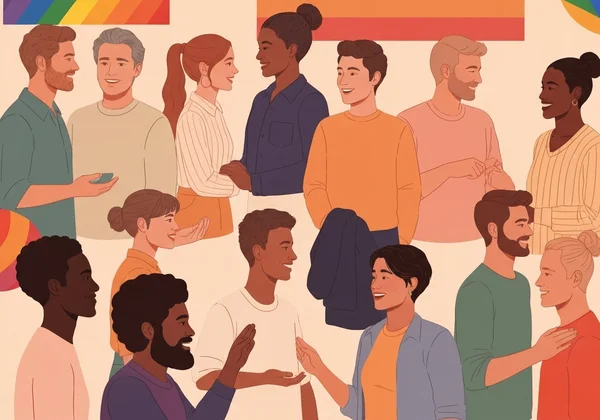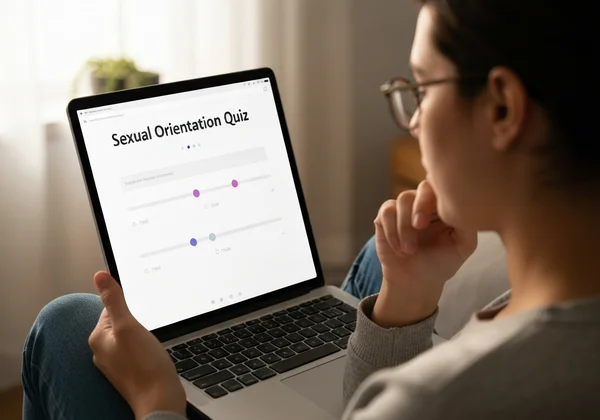Sexual Orientation Guide: Take Our LGBTQ+ Orientation Quiz & Understand Your Identity
Welcome to your guide on the journey of understanding sexual orientation. We understand this can be a confusing, yet exciting time, and this space is created to demystify the beautiful world of human attraction. Whether you're exploring your own identity, trying to support a friend, or are simply asking yourself "Am I gay?", you've come to the right place. Is it normal to question my sexuality? The answer is a definitive yes. Questioning is a natural part of self-discovery. If you're seeking guidance, our free LGBTQ+ orientation quiz is designed to help. This comprehensive sexual orientation guide offers clarity, affirmation, and a safe space to learn, reflecting our commitment to helping you begin your self-discovery with confidence.

Understanding Sexual Orientation: What is Your LGBTQ+ Orientation?
For a long time, conversations about attraction were very limited. However, human experience is far richer and more complex than a simple binary. Understanding the fundamentals of sexual orientation is the first step toward appreciating this diversity and finding your own place within it.
What Exactly Is Sexual Orientation?
At its core, sexual orientation refers to a person's enduring pattern of emotional, romantic, and/or sexual attraction to other people. It's about who you are drawn to and who you connect with on a deep level. It's a fundamental part of who you are, but it doesn't define your entire being. Think of it as one of the many threads that make up the unique tapestry of your identity.
Sexual Attraction vs. Romantic Attraction: Key Differences
A common point of confusion is the difference between sexual attraction and romantic attraction. Sexual attraction is the desire for sexual contact with another person. Romantic attraction, on the other hand, is the desire for a romantic relationship, which might involve emotional intimacy, companionship, and affection, but not necessarily a sexual component. For many people, these two align, but for others, they don't. This is known as the Split Attraction Model, and it's a valid way to experience your feelings.
The Fluidity of Sexuality: Can Your Orientation Change Over Time?
One of the most liberating concepts in modern psychology is sexuality fluidity. This idea acknowledges that for some individuals, sexual orientation can evolve and change throughout their life. Your feelings today might be different from your feelings five years ago, and that is perfectly okay. This journey of self-awareness is personal and unique. There's no fixed timeline or destination; the goal is to honor how you feel in the present moment.

Exploring the LGBTQ+ Spectrum: A Comprehensive Overview
The LGBTQ+ acronym represents a diverse community of identities. Understanding these different labels can provide a language to describe your own experiences and connect with others who feel the same way. Remember, labels are tools for understanding, not boxes to confine you. If a label feels right, you can use it. If not, you don't have to.
Heterosexuality: Understanding Straight Identity
Heterosexuality, often called "straight," describes individuals who are emotionally, romantically, or sexually attracted to people of the opposite gender. This is the most socially recognized orientation, but it's just one of many valid identities on the spectrum.
Homosexuality: The Journey of Gay and Lesbian Identity
Homosexuality describes attraction to people of the same gender. A man who is attracted to men is often called gay, and a woman attracted to women is often called a lesbian. These identities have rich histories and vibrant cultures. If you're asking yourself, "how do I know if I'm gay," exploring these feelings is a profound part of self-acceptance. A confidential online gay test can be a useful tool for reflection, and we encourage you to explore your orientation in a safe environment.
Bisexuality: Attracted to More Than One Gender
Bisexuality is an orientation that describes attraction to more than one gender. A bisexual person can be attracted to both men and women, or more broadly, to people of their own gender and other genders. This attraction doesn't have to be equal or simultaneous. If you're wondering, "am I bisexual?", know that bisexuality is a complete and valid identity, not a phase or confusion. A bisexual test can sometimes help organize these thoughts.
Pansexuality: Attraction Beyond Gender
Similar to bisexuality, pansexuality describes attraction to people regardless of their sex or gender identity. The key difference is that pansexuality explicitly includes attraction to people who identify outside the gender binary, such as non-binary or genderqueer individuals. For pansexual people, a person's gender is not a determining factor in their attraction.
Asexuality & Aromanticism: Exploring Lack of Attraction
Asexuality is an orientation characterized by a lack of sexual attraction to others. Asexual (or "ace") individuals may still experience romantic attraction, form deep emotional bonds, and desire relationships. Aromanticism, conversely, is a lack of romantic attraction. Someone can be asexual, aromantic, both, or neither. These identities are crucial parts of the spectrum.
Queer: An Umbrella Term for Diverse Identities
Queer is an umbrella term that has been reclaimed by many in the community to describe sexual and gender identities other than straight and cisgender. It's often used to express a more fluid or non-normative identity, embracing the complexity of attraction and gender without needing a more specific label.

Beyond Orientation: Gender Identity and Expression
To fully grasp the landscape of identity, it's vital to understand concepts that are related to, but distinct from, sexual orientation.
Sexual Orientation vs. Gender Identity: A Clear Distinction
While often confused, these are two different things. Sexual orientation is about who you are attracted to. Gender identity is about who you are—your internal, deeply held sense of your own gender. For example, a transgender man (someone assigned female at birth who identifies as a man) can be gay, straight, bisexual, or any other orientation.
Understanding Gender Expression: How We Present Ourselves
Gender expression is how we outwardly present our gender. This can include our clothing, hairstyle, mannerisms, and voice. It's a form of self-expression and may or may not align with societal expectations of gender. Your gender expression is your own and doesn't determine your sexual orientation or gender identity.
Navigating Your Own Journey: Self-Discovery & Support
Understanding these terms is helpful, but the most important part is applying this knowledge to your own life with kindness and patience.
Signs You Might Be Questioning Your Sexual Identity
Questioning can look different for everyone. It might involve daydreaming about same-sex relationships, feeling disconnected from straight culture, finding yourself consistently drawn to LGBTQ+ characters in media, or simply having a persistent feeling that something doesn't quite fit. These are all valid starting points for deeper reflection.
Am I Gay? Common Questions and How to Know
Many people find themselves asking, "Am I gay?" This question often arises from deep feelings of attraction, emotional connection, or a sense of 'difference' from heterosexual peers. There's no single checklist for the signs of being gay, but common indicators can include consistent attraction to people of the same gender, finding more fulfillment in same-sex emotional or romantic fantasies, and feeling a stronger sense of belonging within LGBTQ+ spaces. An am I gay quiz can offer a structured way to explore these feelings privately.
Finding Your Community: Resources and Support Systems
You are not alone. Finding a community can be incredibly affirming. This could mean connecting with an LGBTQ+ club at school, finding online forums, or confiding in a trusted friend or family member. Surrounding yourself with support makes the journey of self-discovery less isolating and more empowering.
The Role of Tests and Quizzes in Self-Exploration
So, how do you sort through these feelings? Online tools can be a valuable first step. A well-designed sexual orientation test can act as a guided journal, presenting questions you may not have thought to ask yourself. Whether it's a comprehensive LGBTQ+ orientation quiz or a more specific gay test, it provides a private, pressure-free space to reflect on your attractions and emotions. While no single am I gay test can define you, it can offer insights that help you understand yourself better.

Embracing Your Authentic Self: Your Ongoing Journey
Your journey of understanding your sexual orientation is deeply personal and unfolds at its own pace. There is no right or wrong way to feel, and no deadline for having it all figured out. The goal is not to find a perfect label but to embrace your authentic self with compassion and courage. Every step you take, every question you ask, is a brave move toward living a more honest and fulfilling life.
If you are ready to reflect further, we invite you to continue your exploration. Taking a moment for guided self-reflection can be a powerful and illuminating experience. Start your journey today and see what you might discover.
Frequently Asked Questions About Sexual Orientation
Am I gay, or just confused about my feelings?
Confusion is a normal part of exploration. Many people experience uncertainty as they try to understand their feelings. Give yourself time and space without pressure. Reflecting on your patterns of attraction can offer clarity, and our am I gay test can provide a structured starting point for your reflection. These tools, like a free orientation quiz, are designed to help you think through these complex emotions.
How do you know if you're gay or bisexual?
There is no single "aha!" moment for everyone. For some, it's a sudden realization; for others, it's a gradual understanding. A helpful step can be taking a gay quiz or bisexual test not for a definitive answer, but to see what questions resonate with you. Ultimately, knowing your orientation is about internal self-awareness and accepting who you find yourself consistently drawn to emotionally, romantically, and/or physically.
Can someone's sexual orientation genuinely change over time?
Yes, sexuality can be fluid. Some people find their orientation remains stable throughout their lives, while others experience shifts in their attraction. This doesn't invalidate your past or present feelings. Acknowledging this fluidity can be empowering, as it allows you to honor your authentic self at every stage of life.
What is the difference between gay and bisexual?
The primary difference is the scope of attraction. Being gay or lesbian refers to attraction to people of the same gender exclusively. Being bisexual refers to attraction to more than one gender, such as your own gender and other genders. Both are whole and valid identities.
Is it normal to question my sexuality?
It is absolutely normal. Questioning your sexuality is a sign of introspection and self-awareness. Society often presents a very narrow view of identity, so stepping outside of that to explore who you truly are is a courageous act. Remember, your journey is valid, and you deserve to explore it at your own pace.